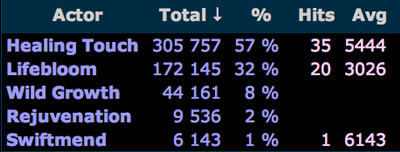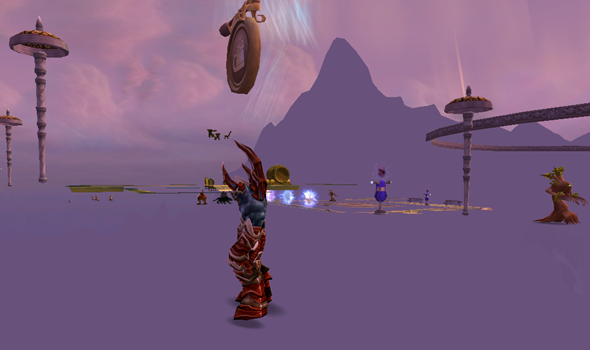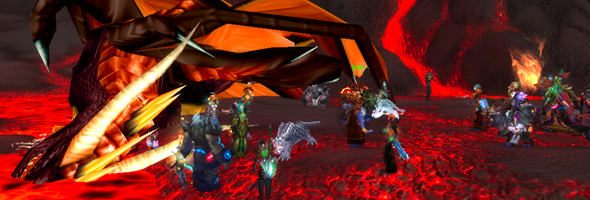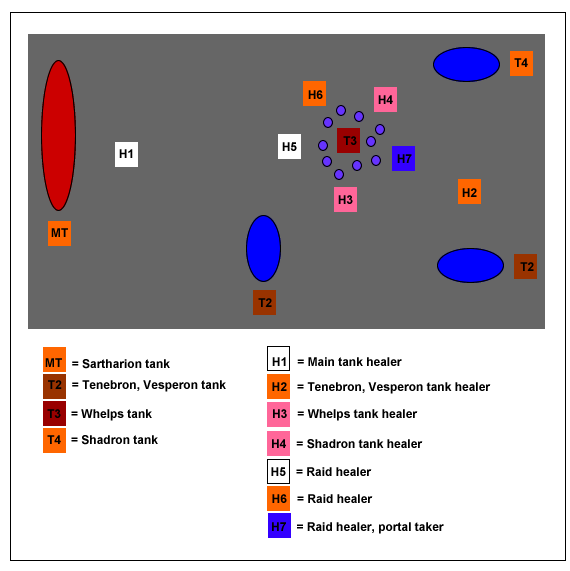
Perhaps more than any other healing class, Wrath of the Lich King has revolutionized the way druids heal. I’m going to take a bit of a look back to where we came from as a way to help understand any troubles druid healers might face at present when we try to figure out what our role in raids should be.
Back in the “Good” Old Days
I came of age as a healer during the BC raid content, and I think part of me will always missing rolling Lifebloom stacks on four different tanks during the Hyjal trash waves. Lifebloom spam may have been widely criticized, but at the time it was effective and felt very dynamic for the player. The timing was tight enough to require tank-specific macros, which I miss, because I could always change their icons to a pig whenever I got mad at them (sorry, Brio). However, when healers argue now that they don’t want to be locked into a rotation, they’re probably thinking of something like old-school LB rolling with horror. That was a rotation, all right–but it left me dizzy. I had to keybind Lifebloom twice–both to my mouse clickwheel and to F. The “F” was for when I needed to refresh while turning with the mouse. At the time, there was no way to increase the 7 sec Lifebloom rotation, and the penalty for letting the stack fall off was fairly severe. I never ran into mana problems, but sometimes the tank would take more damage than I liked if their stack slipped off, and I had few ways to play catch-up. If one tank’s stack went, then most likely all four would.
Even some boss fights made Lifebloom spam worthwhile. On Illidari Council, I used to assign Bonkers to roll LB on three tanks, giving him 1 GCD per cycle free to do “whatever he wanted.” Let me add that the healing buffer Bonkers provided to three of the tanks won the fight for us on more than one occasion. Why did I give the assignment to Bonkers and not myself? Because Bonkers is quicker than me. My assignment, keeping up the group on Malande, was a lot easier. The odd thing is, these kinds of assignments seemed great to Resto Druids at the time–1 GCD free? That’s amazing.
Now that I think about it, the Good Old Days don’t seem so great after all.
Broccoli, v. 3.0
Patch 3.0 brought new tools for the druid healer, offering flexibility where before we had none. However, it strikes me that many Broccoli Stalks might be a little bewildered by all our new toys. And if we’re confused, imagine what it’s like to do healing assignments for a resto druid these days. A few days ago I came across this topic on PlusHeal forums, posted by Siha of Banana Shoulders:
So, I’m the healing lead for my guild, and it usually falls to me to do healing assignments.
I’m having some trouble deciding how best to make use of resto druids. I know in TBC I always used to use them for a multi-tank assignment, keeping a bunch of people hotted up with Lifebloom, but I’m not really on top of all the resto druid changes in WotLK yet.
The talented Siha, as always, gets right to the point with her post. I replied in the topic, but I think that the question has enough merit to warrant a full-length post.
So, what do we do with the newly-versatile druid? After looking at my own performance and those of my Cruciferous Vegetable buddies in Conquest, I am convinced that Resto Druids can be assigned in two different ways for Wrath content. I’m going to showcase a couple of meters-topping druid performances to show just how versatile trees are these days
Raid Healing
This assignment is the most obvious for a resto druid. Wild Growth, due to its higher total healing and it’s status as a heal over time spell, suffered less from the recent nerf than Circle of Healing did. With Rejuvenation, Wild Growth, and perhaps a glyphed Healing Touch in the mix, druids have a powerful toolkit to deal with raid damage.
Let’s take a look at the meter breakdown from an expert druid healer on Gluth, which features heavy raid damage:

Now, the meter % alone might not mean much, but let’s factor in healing assignment. Both S13 and I were assigned to heal the kiters on Gluth, and we have similar gear. Why did he outperform me? Let’s take a look at the abilities breakdown.

Take a look at S13’s Healing Touch percentage and the amount it hits for on average. That tells me–even if I didn’t already know–that he’s using the Healing Touch glyph. The fact that he’s able to get so much healing out of a direct healing spell also tells me that S13 is fast. He’s really great at reacting to situations. Notice here that he’s also made a lot of use of Lifebloom–nerfed it maybe, but useless it is not. This WWS report is post-WG nerf, by the way. S13’s performance shows how little a healer has to rely on Wild Growth to be effective (and to post good numbers while doing so). If I were to take a look at S13’s targets, I would see a lot of healing on the 5 kiters, but also a decent amount on other members of the raid. S13 is a great raid healer because he’s able to pay attention to a lot of things at once and to accurately judge when he can go a bit beyond the boundaries of his assignment.
Tank Healing
Yes, I know druids have an AoE heal now. That doesn’t mean that we’re not still good at our old role, healing the main tank. I’ve just shown you the WWS from a druid who excels at raid healing. Now, I’m going to show you my own meter performance. I am a tank healer. That’s what I like, and that’s what I’m good at. I’ve been healing a warrior MT so long that I know how the damage hits and what I can do to fix it. I don’t pretend to be the best at anything, but if I’m in charge of healing assignments, I’m going to stick myself to a tank. It’s not usually very showy on the meters, but I’m going to give you a peep at the one fight in Naxx that does let tank healers show off–Patchwerk.

To understand this image properly, you should probably know that Silvia and I were assigned to heal the offtank, a druid, while S13 and Arktos were assigned to the main tank, a warrior. For the life of me, I can’t remember what Kaldora, our holy priest, was assigned to that day. The nature of the fight dictates that there is simply more healing to do on the off tank(s) than on the main tank, so an off-tank healer is going to post higher numbers. Be that as it may, this is nonetheless a good performance from me personally. Let’s look at the breakdown of what I did.

First of all, notice the presence of Regrowth. I use the Regrowth glyph, and a fight with heavy tank damage also shows it off. Meanwhile, I keep Lifebloom rolling on the primary off-tank. As for Rejuvenation, I keep it on both the primary off-tank and the backup. At higher gear levels, your raid is less likely to need two offtanks for Patchwerk. I used to post even more impressive numbers when two off-tanks took heavy hits. I would keep up my full hot rotation on the druid and use Rejuvenation, Swiftmend, and a Nature’s Swiftness/Healing Touch on the secondary off-tank. I always say that Resto Druids can heal two tanks as well as one, and it’s very nearly true. This is a lesson I learned in Zul’Aman, and it still serves me well on a multi-tank fight like Patchwerk. One thing an MT healer can never forget is the power of Swiftmend–it’s easy to ignore, but make yourself use it whenever you can. You’ll notice that Nourish is missing from my rotation, even though I have the 4pc T7 bonus. Regrowth is simply better if the damage is high. I will use Nourish on fights where Regrowth might be overheal, or on long fights that might stress my mana.
My message to healing leads is this: resto druids can tank heal. You might think that only a paladin or discipline priest will work, but don’t discount the resto druid, particularly one who’s used to this job. We may have a discipline priest solo-healing the MT on Sarth 3D, but that doesn’t mean a resto druid cannot be assigned to the task. In fact, some days I want to arm-wrestle Mallet for the job.
Glyphs and Talents
As you can see from our performances, S13 and I, despite having almost the same gear, are very different healers. There are slight differences in talents and glyphs that support each of our preferred roles. Here are my thoughts on how to set up a resto druid to excel at either raid healing or tank healing.
Raid Healing
In terms of talents, I suggest Tranquil Spirit to make Healing Touch and Nourish more efficient, a fully talented Gift of the Earth Mother, and perhaps Naturalist for the shortest Healing Touch cast time. As an alternative, you might put either 1 or 2 points into Improved Tranquility. I find this spell very useful when I can remember to use it. It shines on any fight where the raid is fairly close together and AoE damage as high–I’ve used Tranquility to good effect on Loatheb, Sapphiron, and OS3.
To heal S13-style, you will absolutely need to glyph Healing Touch. I am extremely impressed with the HPS of this spell, and it only gets better as your gear scales. In addition, we can all afford the mana at this point. S13 doesn’t run OOM any more than I do. The raid healer has some amount of choice in the other glyph slots. I suggest Swiftmend and Innervate, but if you find that you never use Swiftmend, Lifebloom will also work. The Regrowth glyph, while good in and of itself, won’t do much for you if you’re never assigned to tanks.
Tank Healing
In terms of tank healing talents, the most important one to have is Nature’s Splendor from the Balance tree to extend HoT duration. However, all raiding restos should have this talent. I also use Tranquil Spirit to support my Nourish (in case I ever use it), a fully maxed Improved Regrowth, and Gift of the Earthmother for easier HoT refreshes. I do not have Living Seed at the current moment. It accounted for less that 1% of my total healing when I had it. If I get enough haste to remove points from Gift of the Earthmother, I may try it again. I have a feeling that either 1) Living Seed will do more healing in Ulduar or 2) it will get some sort of buff in the future. As for Replenish, either build should skip it because it’s endlessly terrible, but the tank healer especially does not need it.
In terms of glyphs, I use Swiftmend, Regrowth, and Innervate for main tank healing. The only debateble choice here is Innervate. I prefer it over Lifebloom, but Keeva of Tree Bark Jacket, who also main tank heals often, writes very convincingly in favor of the LB glyph in this recent post. A main tank healer should not glyph Healing Touch. It’s more useful in the large version paired with Nature’s Swiftness.
Conclusions
We’ve come a long way from Lifebloom spam. Whether we’re set to healing tanks or the raid, druids have a variety of techniques now to support their chosen role. We can do it all–just not all at once. If you’re a healing lead, it’s important to get to know your healers. With the new diversity of the druid class, skill and preference start to weigh heavily on how you should assign your druids. So, why not ask them what they like, and what they are good at?










